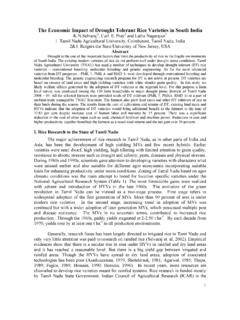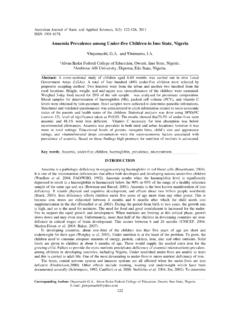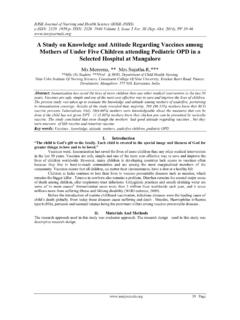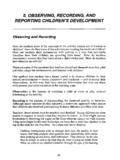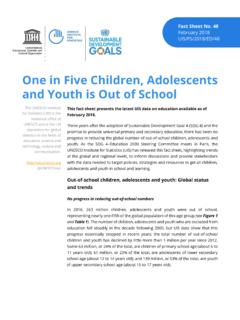Transcription of SOCIOECONOMIC FACTORS INFLUENCING NUTRITIONAL …
1 Bangladesh J. Agric. Econs. XXXII, 1&2 (2009) 63-74 SOCIOECONOMIC FACTORS INFLUENCING NUTRITIONAL STATUS OF UNDER- five children OF AGRARIAN FAMILIES IN BANGLADESH: A MULTILEVEL ANALYSIS Jahangir Al om M ohammad Amir ul Isl am Md. Abdul Q uddus AB STRACT The NUTRITIONAL status of under five children is a sensitive sign of a country's health status as well as economic condition. This study investigated differential impact of some demographic, SOCIOECONOMIC , environmental and health related FACTORS on NUTRITIONAL status among under five children in Bangladesh whose fathers' occupation was agriculture. The study used Bangladesh Demographic and Health Survey 2007 data.
2 Bivariate analysis, multivariate analysis (Cox's linear logistic regression model) and two-level random intercept binary logistic regression analysis were used to identify the determinants of under- five malnutrition. The analyses revealed that percent of the children were severely stunted, percent were moderately stunted and 51 percent were not stunted. This study also found that percent of the children were severely wasted, percent were moderately wasted and 80 percent were not wasted. Furthermore, the analyses revealed that percent of the children were severely underweight, percent were moderately underweight and 53 percent children were not underweight.
3 The main contributing FACTORS for under five malnutrition were found to be child's age, birth order, mother's education, father's education, family wealth index, sanitation facility, place of delivery, place of residence and division. Community level variations were found significant for wasting only in the analyses. I. INTRO DUCTIO N Malnutrition is a sustaining probl em in man y of the devel oping countries. It is one of the main causes of m orbidit y and m ortality am ong children under fi ve years of age (Martorell et al., 1992). In devel oping countri es malnutriti on i s an important r oot of in fant and young child m or tali t y and r educed li fe span (UNDP, 2008).
4 It is a ssociat ed with m or e than hal f of all deaths of children worldwide. In Bangladesh am ong the under fi ve childr en 43 percent wer e stunt ed (chroni c malnutriti on), and 16 percent were severel y stunted. About 17 percent of children under fi ve were wa st ed (acute malnutrition), and 3 percent were severel y wa sted. About 41 percent of children under fi ve were under weight (under nutrition), and another 12 percent were severel y under weight (NIPORT e t al. 2009). A large number of studies conduct ed a cross the worl d on the status and determinants of child malnutrition (for example, Hong e t al.)
5 2006; Islam e t al., 1994; Ra jar etnam and Hallad, 2000; The authors are respectively ex-post graduate student, Associate Professor and Professor, Department of Agricultural Statistics, Bangladesh Agricultural University, Mymensingh-2202. Contact: 64 The Bangladesh Journal of Agricultural Economics Rayhan and Khan, 2006; Shrimpton and Yongyout, 2003; Smith and Haddad, 2000; Tharakan and Suchindran, 1999). Tharakan and Suchindran (1999) studied the status and determinants of child malnutrition on the basis of stunting, wasting and underweight using the data of a national cross-sectional study of Botswana.
6 The study identified several biological, social, cultural, economic, and morbidity FACTORS such as age of child, birth weight, duration of breastfeeding, gender of household head, residence, type of house, toilet facility, parents' education, child caretaker, milk and dairy products, staple food, and incidence of cough and diarrhoea as the determinants of child malnutrition. Rajaretnam and Hallad (2000) studied the determinants of severe underweight among children of ages 12-47 months using the NFHS-II data of India. It was found that the Indian children become less and less underweight but more and more stunted after reaching 2 years of age.
7 Sex of child, birth weight, birth order, birth interval, regional settings, mother's education, mother's age, antenatal and natal care, and incidence of diarrhoea were identified as important predictors of child underweight. Rayhan and Khan (2006) investigated the impact of some demographic, socio-economic environmental, and health related FACTORS on child NUTRITIONAL status using the nationwide data of the Bangladesh Demographic and Health Survey (BDHS) 1999-2000. The study observed that previ ous birth interval, size at birth, and mother's educati on had significant influence on chronic malnutrition. Size at birth and mother's NUTRITIONAL status had significant influence on both wasting and underweight.
8 Hong et al. (2006) found str on g sign i fi cant a ssoci a ti on bet ween h ouseh ol d wea l th inequality and chronic childhood under nutrition in Bangladesh by utilizing the nationwide data of Bangladesh Demographic and Health Survey (BDHS) 2004. The findings of the study showed that children of poorest household had highest risk of being chronically malnourished than the children of wealthiest households. The study suggested to reduce poverty and to make services more available to the poor households for the improvement in overall childhood health and NUTRITIONAL status in Bangladesh. Using the data of Bangladesh Demographic and Health Survey (BDHS) 1996-97, Kiess et al.
9 (2000) studied the FACTORS associated with low Height for age (HAZ) and Weight for height (WHZ), and found that parents' illiteracy and insufficient antenatal care (ANC) visits were significant FACTORS of lower HAZ. The incidence of diarrhoea and fever in last two weeks, receiving no BCG and measles vaccines were found as the significant predictors of lower WHZ. On the other hand, birth interval, mother's body mass index (BMI) and regional settings (division) were found as significant FACTORS of both lower HAZ and WHZ. Pryer et al. (2003) conducted a panel survey between 1995 and 1997 in Dhaka slum population to identify socio-economic, demographic and environmental FACTORS that predict better HAZ for children under 5 years of age.
10 They observed that 31 percent children had HAZ greater than - 2. Using logistic regression analysis, they found that better nourished children were more likel y t o ha ve tall er m others, bel onging t o h ousehol ds ha ving femal e h ousehol d-hea d, higher income, hygienic latrines, and more floor place. Unfortunately none of the existing literature highlighted the possibility of community effect on malnutrition. In developing countries likelihood of the presence of community effect is high (Islam, 2010). Hence this study would explore this area with suitable statistical methods, SOCIOECONOMIC FACTORS INFLUENCING NUTRITIONAL 6 5 namely multi-level modeling (see Goldstein, 2003).



